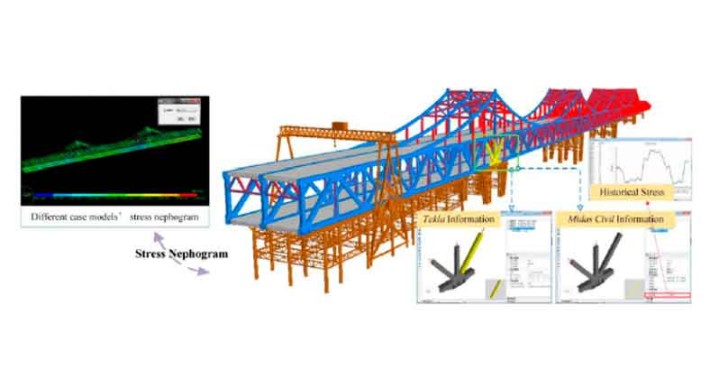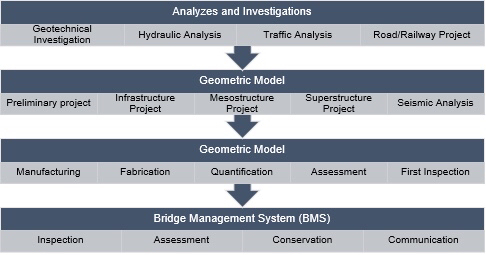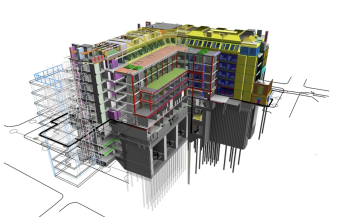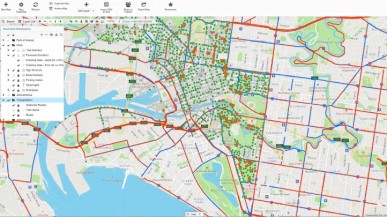Zigurat Global Institute of Technology
Blog / BIM & Construction Management
BrIM (Bridge Information Modeling): Six uses and practical applications
Categories

Although the application of Building Information Modeling (BIM) in the construction sector is expanding every day, its use in transport infrastructure has still been limited and slow. Integrated Civil Management (CIM) has been used primarily for the operations and management sector. On the other hand, Civil information Modeling (CiM) has focused on virtual 3D modeling of transport infrastructures in the design phase .
In this context, industry and academia have developed several studies in the area of CiM to investigate its different applications. In this circumstance and in order to complement the research, the purpose of this article is to present a comprehensive review of six uses and applications of Bridge Information Modeling (BrIM), which is the BIM applied to bridge structures, highlighted in academic publications in the last 15 years. On Zigurat's BIM Experts blog in March 2020, some BrIM apps were discussed. However, in this text it will be possible to find more practical uses and applications, dealt with in academic literature.
1. Accelerated Bridge Construction (ABC)
In ABC, BIM can be used from conceptual design to construction . The BIM application in ABC (Figure 1) can increase the efficiency and sustainability of buildings by reducing waste throughout the lifecycle. The use of BIM can enable complex projects and reduce information requests and change requests, which can provide cost savings of between 5% and 9% during construction , contributing to the reduction of rework. Therefore, BIM can be used to model the bridge and associated diagrams, perform design analyses as well as plan the elevation of precast concrete elements with self-propelled modular transport vehicles (SPMTVs), establishing the surrounding grade to facilitate the transport of the superstructure. Figure 1. BIM application in ABC construction by the Massachusetts Department of Transportation in 2011 .
Figure 1. BIM application in ABC construction by the Massachusetts Department of Transportation in 2011 .
2. Structural analysis
The advantages of a BIM software used for planning can be combined with those used for structural analysis . In this way, structural position diagrams can be created in the BIM model or automatically generate reinforcement drawings based on structural analysis as well as directly exporting the finite element software (FEM) calculation values in the form of 3D reinforcement or assisting in analysis globals, for example. Figure 2 presents some possible analyzes and diagrams in bridges working in BIM softwares.  Figure 2. Structural analysis: (a) reinforcement detailing ; (b) FEM model and calculated rotation measurements ; (c) integrated analysis information applications ; (d) FEM model in ADINA and SCIA Engineering .
Figure 2. Structural analysis: (a) reinforcement detailing ; (b) FEM model and calculated rotation measurements ; (c) integrated analysis information applications ; (d) FEM model in ADINA and SCIA Engineering .
3. Inspection
Bridge information modeling for the inspection and evaluation method (BIEM) provides a way to collect, store and use damage information based on the location of an inspected bridge . In this regard, BIM software can be used to analyze and present this information to aid decision-making, provide maintenance recommendations, and allow the technician to assess damage. Among the various mechanisms that can be linked to BIEM, the following stand out (Figure 3): unmanned aerial vehicle (UAV) for monitoring and maintenance of structures; remotely piloted aircraft systems (RPAS), reducing time, cost and risk for operators; robot system for automatic crack detection; unmanned marine vehicles (UMV) for wreck mapping; laser digitized point clouds for inspection and data extraction; and intelligent transport systems (ITS) for an automated process of capturing, storing, analyzing and managing data. 
Figure 3. Devices that can be coupled to the BIEM: (a) unmanned aerial vehicle (UAV) ; (b) laser scanned point clouds ; (c) robot system for automatic crack detection .
4. Structural Health Monitoring (SHM)
SHM can be understood as tracking the reflections of a structure to determine anomalies, detect deterioration and identify damage for decision making . In this sense, it is extremely important in the maintenance and management of a bridge to monitor its structural health. SHM can work using wired and wireless sensors for data capture, which can be integrated with BIM to perform analysis (Figure 4). The use of sensors can improve the accuracy of operations and management activities. The amount of information captured helps to build a more reliable database, improving the quality of infrastructure management and maintenance. In addition, a numerical and machine learnig modeling can be developed to deeply analyze this information in order to improve data handling, for example.  Figure 4. Use of wired and wireless sensors for data capture and integration with BIM to perform analyzes .
Figure 4. Use of wired and wireless sensors for data capture and integration with BIM to perform analyzes .
5. Virtual Design and Construction (VDC)
VDC benefits the design and management industry through better use and visualization of data, supporting the entire infrastructure lifecycle, particularly in 4D planning. VDC can help improve the quality of feasibility studies, visualization of the construction process, comparison of different project scenarios, operational research and documentation. Therefore, the planning and programming steps can be carried out more precisely with the use of this methodology as well as the management of resources, which makes it more efficient with the visualization of the progress of the work (Video 1). Finally, VDC can also help in asset management with realistic models that help managers . https://www.youtube.com/watch?v=tJCUPsw1qeE&t=1s Video 1. Federated bridge model - VDC and 4D planning developed in Autodesk Navisworks Manage 2021 software.
6. Bridge Management System (BMS)
In BMS, BIM can be used to reconcile technological advances in automation and communication, allowing for the integrated management of all phases of a bridge's lifecycle (Figure 5). Thus, several BrIM applications integrated with BMSs have produced practical results, such as: obtaining detailed cost estimates using the integration of the BrIM visualization feature with specific attributes of intelligent BMS components; identifying and selecting the best bridge solution based on constrained factors such as cost-effectiveness using artificial intelligence and BrIM components and BMSs; automatic document extraction and retrieval; prevention of bridge deterioration and prioritization of maintenance decisions, detection of fragmentation damage through points cloud, and integration of damage components in a BMS.

Figure 4. Constituent processes to be included in the analysis model for BMS usage. Author: José Vinícius Silva Martins, Civil Engineer from Centro Universitário de Brasília (UniCEUB), Alumni of International Master in BIM Management for Infrastructure, Civil Engineering and GIS, specialist in reinforced concrete structures and bridges and currently holds the position of Civil Engineer at Executive Board of the National Department of Transport Infrastructure (DNIT) of Brazil. 



